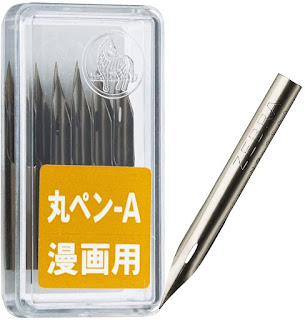Affiliate Disclaimer: For full transparency, you should know that many of my links in my posts are affiliate links. As an Amazon affiliate, I receive a small commission when readers purchase items using my affiliate links. This helps me fund the blog domain costs, and you will not be charged extra if you buy anything using my links.
In my previous post I think I inadvertently and unfairly
blamed the Inktober 2021 prompts for my lackluster performance. That’s pretty
lame because the inspiration and resulting artwork must come from my own
creativity, regardless of how much a prompt resonates with me. After spending
my spring and summer doing interior design and home improvement projects, I have
jumped into Inktober cold, not having so much as sketched over the last several
months. Additionally, while I love pen and ink, my experience with it is
inconsistent. I have had ink go bad before I even use half the bottle (it
stinks when it goes bad, FYI). So for this week’s post I will go over some
basics that I am revisiting, and my reviews will center on the components of dip
pens: holders and nibs.
A Tip from a Serial Offender:
One thing about dip pens that I always underestimate is their sharpness. Unlike most calligraphy nibs with square tips, the steel tips on drawing nibs are almost needle sharp. For this reason, you don’t want to use wimpy paper as these nibs will scratch right through the surface sizing. The result is annoying paper fiber dingleberries over which the Ink tends to feather and bleed. This can also happen if you use too much pressure while drawing on heavier paper, so don’t be too heavy handed with your dip pens. It’s a tragic event that could put one off pen and ink completely, and we can’t have that, can we?
Pen (Nib) Holders
Currently I am using Japanese comic nib holders by Tachikawa,
but choosing a holder is personal. Most artists have their favorite pens and
pencils that they reach for more than others. Often the weight and shape of a
utensil is what makes it most comfortable in the hand, and a nib holder is no
different. I own classic Speedball nib holders that are probably at least 10
years old. These are the easiest to find in the U.S, and they cost very little.
I switched to the Tachikawa T40 and TP-40 holders because the larger barrel is
more comfortable for me. The Tachikawa T-40 has a wood handle, while the TP-40
is plastic, but they are otherwise the same model, and they come with caps to protect
your nibs. They have soft rubber grips
and fit a wide variety of nibs including the small crow quill nib which has a cylindrical
base and is known as a mapping nib among manga artists. There are also holders
that only accommodate these nibs, such as the Speedball Hunt
Crow Quill Point Holder. Again, this is a cheap alternative but it’s tiny, and
I find it messy to remove dirty nibs from the little guy.

holder(image from Amazon.com)
Nibs, Glorious Nibs!
There are so many nibs available for drawing and calligraphy
that I cannot begin to review a fraction of them. My knowledge is also limited,
so I recommend the JetPens
blog for learning about every type of pen point. I am not affiliated with
the store, but I have had positive experiences when I bought inking supplies
from them, and I have learned a lot from the blog.
I am not a manga
artist, but the comic nibs made for manga are some of my favorites. They are
popular among artists because they have firm, pointed tips and low to medium
flexibility. This limited flexibility allows for clean, consistent lines, which
is a bonus if you have shaky hands. Manga nibs are also elastic, meaning that
they spring back into shape immediately after each stroke, which is also beneficial
for steady lines. Like flexibility, elasticity also varies by nib. You need to
play with different types to find which ones are best suited to your drawing
style, but as a rule, beginners tend to do better with nibs that are low in
flexibility and elasticity as they are easier to control. Manga nibs are also
known for their stable line width. Width changes as you apply more pressure to
the nib (remember, though, the dingleberries!), but you can get reliable widths
if you use consistent pressure.
The most common nibs used by comic artists are the G, Spoon
(Naji/Tama), School, and Mapping (Maru) nibs, but these types can vary between brands.
Some are harder (less flexible) than others. I bought Zebra
G and Spoon
(Tama), and Deleter
Maru nibs. Of all these, the G pen
is the most flexible and produces a wide variety of line widths, but it may be
hard to control if you are new to pen and ink drawing. Spoon nibs produce the
most consistent lines and are beginner-friendly, but they are not suited for
varied line expression. They are best for scenery and inanimate objects. School
pens are smaller than G or Spoon types and fall between the two in flexibility.
They are recommended for beginners who are not quite ready for G pens. The
mapping (Maru) nib makes the finest lines of all three, perfect for details
such as eyebrows or lashes. It resembles the Hunt crow quill tips mentioned
above, so be sure to check your holder to make sure it will accommodate the
tiny nib.
 |
| Zebra Maru (mapping) nib (image from Amazon.com) |
 |
| Hunt/Speedball 512 nib (left), Zebra spoon nib (right) |
Next Friday I will talk about inks and papers that I have tried over the years. What is your favorite pen and nib combo? Do you think there is a difference between Japanese and western brands, and which do you prefer? I would love to hear your feedback!

No comments:
Post a Comment